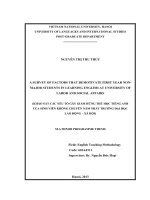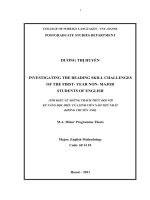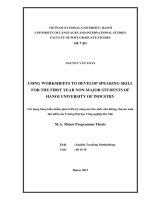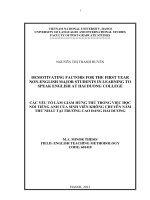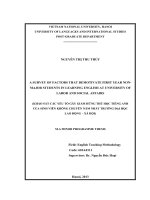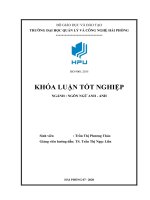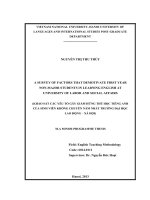Dimotivating factors for the first year non-English major students in learning to speak English at Hai Duong college = Những yếu tố làm giảm hứng thú trong việc
Bạn đang xem bản rút gọn của tài liệu. Xem và tải ngay bản đầy đủ của tài liệu tại đây (985.48 KB, 59 trang )
i
VIETNAM NATIONAL UNIVERSITY, HANOI
UNIVERSITY OF LANGUAGES AND INTERNATIONAL STUDIES
FACULTY OF POST-GRADUATE STUDIES
****************************************
NGUYỄN THỊ THANH HUYỀN
DEMOTIVATING FACTORS FOR THE FIRST YEAR
NON-ENGLISH MAJOR STUDENTS IN LEARNING TO
SPEAK ENGLISH AT HAI DUONG COLLEGE
CÁC YẾU TỐ LÀM GIẢM HỨNG THÚ TRONG VIỆC HỌC
NÓI TIẾNG ANH CỦA SINH VIÊN KHÔNG CHUYÊN NĂM
THỨ NHẤT TẠI TRƯỜNG CAO ĐẲNG HẢI DƯƠNG
M.A. MINOR THESIS
FIELD: ENGLISH TEACHING METHODOLOGY
CODE: 601410
HANOI, 2012
ii
VIETNAM NATIONAL UNIVERSITY, HANOI
UNIVERSITY OF LANGUAGES AND INTERNATIONAL STUDIES
FACULTY OF POST-GRADUATE STUDIES
****************************************
NGUYỄN THỊ THANH HUYỀN
DEMOTIVATING FACTORS FOR THE FIRST YEAR
NON-ENGLISH MAJOR STUDENTS IN LEARNING TO
SPEAK ENGLISH AT HAI DUONG COLLEGE
CÁC YẾU TỐ LÀM GIẢM HỨNG THÚ TRONG VIỆC HỌC
NÓI TIẾNG ANH CỦA SINH VIÊN KHÔNG CHUYÊN NĂM
THỨ NHẤT TẠI TRƯỜNG CAO ĐẲNG HẢI DƯƠNG
M.A. MINOR THESIS
FIELD: ENGLISH TEACHING METHODOLOGY
CODE: 601410
SUPERVISER: DO BA QUY, M.Ed.
HANOI, 2012
iv
TABLE OF CONTENTS
Declaration
i
Acknowledgements
ii
Abstract
iii
Table of contents
iv
List of abbreviations
vii
List of tables and charts
viii
PART A: INTRODUCTION
1
1. Statement of the problem and rationale for the study
1
2. Aims of the study
2
3. Research questions
2
4. Methods of the study
2
5. Scope of the study
2
6. Design of the study
3
PART B: DEVELOPMENT
4
CHAPTER 1: REVIEW OF LITERATURE
4
1.1. Theoretical background of speaking
4
1.1.1. The nature of speaking
4
1.1.2. Definition of speaking
4
1.1.3. The role of speaking in foreign language teaching
5
1.1.4. Factors affecting the learning of speaking
6
1.2.Theoretical background of demotivation
8
1.2.1. Definition of demotivation
8
1.2.2. Factors affecting students’ demotivation
9
1.3. Previous studies on the topic
13
1.4. Summary of the chapter
15
CHAPTER 2: METHODOLOGY
16
2.1. An overview of current situation of teaching and learning
16
v
English at HDC
2.1.1. Hai Duong College
16
2.1.2. The students
16
2.1.3. The teachers
17
2.1.4. The teaching and learning conditions
17
2.1.5. The textbooks
17
2.2. Methodology
18
2.2.1. Subjects of the study
18
2.2.2. Data collection instruments
18
2.2.3. Data collection procedure
20
2.2.4. Data analysis procedure
20
2.3. Summary of the chapter
21
CHAPTER 3: DATA ANALYSIS AND DISCUSSION
22
3.1. Data analysis of students’ responses
22
3.1.1. Students’ attitudes towards speaking skills
22
3.1.2. Students’ ideas about demotivating factors in learning
speaking English
24
3.1.3. Students’ interest and expectations
28
3.2. Data analysis of teachers’ responses
30
3.2.1. Teachers’ opinions on students’ attitudes towards speaking
skills
30
3.2.2. Teachers’ ideas about students’ demotivation in learning to
speak English
31
3.2.3. The frequency of teaching techniques and activities used by
teachers in speaking lessons
32
3.2.4. Teachers’ opinions on what motivates students to learn to
speak English
33
3.3. Major findings and discussion
33
3.3.1. Demotivating factors in learning English speaking skills for
33
vi
the first year non-English majors at HDC
3.3.2. Solutions suggested by the teachers and the students to
overcome demotivation in the learning of speaking skills
35
3.4. Summary of the chapter
36
PART C: CONCLUSION
37
1. Conclusions
37
2. Recommendations
38
3. Limitations of the study
40
4. Suggestions for further studies
40
REFERENCES
41
APPENDICES
I
vii
LIST OF ABBREVIATIONS
BA
Bachelor of Arts
EFL
English as a Foreign Language
ELT
English Language Teaching
ESL
English as a Second Language
HDC
Hai Duong College
L2
Second Language
MA
Master of Arts
PhD
Doctor of Philosophy
viii
LIST OF CHARTS AND TABLES
Charts
Page
Chart 1
Students’ perceptions of the importance of speaking skills
22
Chart 2
Teachers’ interest in speaking skills
28
Chart 3
Teachers’ perceptions of students’ thought over speaking
skills
30
Tables
Page
Table 1
Students’ attitudes towards the learning of speaking skills
23
Table 2
Student’s opinions on student-related factors
25
Table 3
Student’s opinions on teacher-related factors
26
Table 4
Student’s opinions on learning environmental factors
27
Table 5
Student’s opinions on speaking time and the textbook
28
Table 6
Students’ opinions on what motivates them to learn speaking
English
29
Table 7
Teachers’ opinions on students’ participation in speaking class
31
Table 8
Teachers’ ideas about students’ demotivation in learning
speaking English
31
Table 9
The frequency of teaching techniques and activities used in
speaking lessons
32
Table 10
Teachers’ opinions on what motivates students to learn
speaking English
33
1
PART A: INTRODUCTION
1. Statement of the problem and rationale for the study
Language skills have never been more important than today because in a
global world where information travels fast, and people frequently interact across
borders, the ability to communicate effectively is very necessary. It can not be
denied that English is now considered to be a means of international communication
and an important tool to connect countries all over the world. It is English that plays
an essential role in the path of industrialization and modernization as well as in the
process of integration and globalization of every country in the world.
In Vietnam, English teaching and learning has become a great concern over
the last decades. It has been a compulsory program in most of educational campuses
such as institutions, universities, colleges and schools at different levels. There are
more and more people desiring to know and master English because of different
purposes: to pass examinations, to keep up with the latest development in science
and technology in the world, or to cater their practical needs.
Among the four skills known as listening, speaking, writing and listening,
speaking skill plays an important part in language teaching in the context of
Vietnam. For many learners, speaking skill is the most important of the four skills
in a second language in general and in English in particular. However, it is the fact
that most of students at Hai Duong College (HDC) seem to consider speaking skill
to be the most challenging. From observations and teaching experiences, the author
realizes that students pay little attention to communicative skills such as listening
and speaking. They seem to have lost interest in learning English and they are not
active in participating in speaking activities. They feel nervous in speaking class
and become demotivated in learning speaking. These lead to the underachievement
and have a negative effect on students in learning English as a foreign language.
With the desire to identify the factors affecting students’ demotivation and find out
some solutions for this problem, I decided to choose the topic “Demotivating
2
Factors for the First Year non-English Major Students in Learning to Speak English
at Hai Duong College” as the title of my minor thesis.
2. Aims of the study
The major purposes of this study are:
- To identify the demotivating factors affecting the first year non-English
majors learning to speak English.
- To figure out some suggested solutions to eliminate the demotivation and
help to improve students’ speaking skills.
3. Research questions
The study is implemented to find out the answers for the following
questions:
1. What are the demotivating factors affecting the first year non-English
major students in learning to speak English at HDC?
2. What solutions do the teachers and the students suggest to overcome the
students’ demotivation in learning speaking skills?
4. Methods of the study
To achieve the aims of the study, both quantitative and qualitative methods
are employed. The data was collected by means of questionnaires and interview.
Two sets of survey questionnaires, one for students and the other for teachers, were
mainly used to get information and evidence for the study. To get more reliable
data, an interview was conducted. All the comments, remarks, recommendations
and conclusions provided in the thesis were based on the analysis of the data.
5. Scope of the study
This study is limited to the student’s demotivation in learning to speak
English at HDC. Therefore, the investigation of the issue on other skills will not be
included in the study. Furthermore, it should be taken into consideration that the
subjects of the study are the first year non-English majors who are being taught
speaking skill under the communicative approach.
3
6. Design of the study
This minor thesis is divided into three main parts: Introduction,
Development, and Conclusions.
Part A, Introduction, presents the rationale, the aims, the research questions,
the methods, the scope as well as the design of the study.
Part B, Development, consists of three chapters:
Chapter one, Literature review, revises the relevant theories as the base for
carrying out the research. In addition, related studies are also mentioned in this
chapter.
Chapter two, Methodology, provides the methodology underlying the
research which includes the setting of the study, research questions, participants,
data collection instruments, data collection procedure as well as data analysis
procedure.
Chapter three, Data analysis and discussion, shows a detailed presentation of
data analysis to answer the research questions. The discussion of the findings is also
included in this chapter.
Part C, Conclusions, addresses the key issues in the study, comes up with
some recommendations to cope with the problem. Furthermore, this part also points
out some shortcomings of the study as well as provides some suggestions for further
studies.
4
PART B: DEVELOPMENT
CHAPTER 1: LITERATURE REVIEW
This chapter reviews relevant theories and studies that can be the base for
conducting the research. The background knowledge of speaking and demotivation
as well as previous studies concerning the topic of the study will be presented.
1.1. Theoretical background of speaking
1.1.1. The nature of speaking
Of the four macro inter-related language skills: listening, speaking, reading
and writing, speaking seems intuitively the most important. According to Ur (1996),
people who know a language are referred to as speakers of that language, as if
speaking included all other types of skills, and many, if not most foreign language
learners are primarily interested in learning to speak.
Speaking skill requires the masters speak with confidence to carry out a lot
of their most basic transactions. Byrne (1986) proved that the nature of oral
communication is a two-way process between the speaker and the listener involving
the productive skill of speaking and the receptive skill of understanding. When the
speaker starts a message, the listener decodes, and responds to the message in turns.
In spite of not being a set curriculum in most schools, speaking skill has been
illustrated to be a fundamental skill for a child to succeed in life.
1.1.2. Definition of speaking
According to Brown (1994), speaking is an interactive process of
constructing meaning that involves producing, receiving and processing
information. It is “often spontaneous, open-ended, and evolving” but it is not
completely unpredictable. Its form and meaning are dependent on the context in
which it occurs, including the participants themselves, their collective experiences,
the physical environment, and the purpose for speaking.
5
In addition, Chaney and Burk (1998:13) defined speaking as "the process of
building and sharing meaning through the use of verbal and non-verbal symbols, in
a variety of contexts". Bailey (2005:2) also argued that “speaking is the productive,
oral skill. It consists of producing systematic verbal utterances to convey meaning.”
Mackey (1995, cited in Bygate, (1987:5)), affirmed speaking as “oral
expression involves not only the use of right sounds in the patterns of rhythm and
intonation, but also the choice of words and inflections in the right order to convey
the right meaning.”
Brown and Yule (1983) pointed out a useful distinction between two basic
language functions which are transactional function and interactional function. The
transactional function is concerned with the transfer of information whereas the
interactional function is to maintain the social relationships.
According to Nunan (1992), there is a difference between the two types of
conversations called dialogue and monologue. The first type refers to the ability to
give and interrupt oral presentation while the second type refers to the interaction
with one or more other speakers for transactional and interactional purposes.
1.1.3. The role of speaking in foreign language teaching
In the view of language teaching, language has been divided into four macro-
skills: listening, speaking, reading and writing based on the purpose of analysis and
instruction. It is undeniable that speaking skill plays the most important part in
foreign language teaching because it is fundamental to human communication (Ur,
1996). Knowing the language means being able to speak the language. Furthermore,
it is the vehicle to establish and maintain social relationships as well as to achieve
professional advancement.
In the international relationship, English speaking ability is obviously crucial
to be able to participate in the wider world of work. The speaking skill is measured
in terms of the ability to carry out a conversation in the language. For the reasons
6
mentioned above, it is really vital that language teachers should pay great attention
to the teaching of speaking skill.
1.1.4. Factors affecting the learning of speaking
According to Richards & Rogers (1986), one needs to have communicative
competence to be successful in learning to speak a language. However, this is
affected by both subjective factors such as: psychology, linguistics, culture and
objective factors such as: class size, materials used and learning environment.
1.1.4.1. Subjective factors
Cultural factors
Language and culture may be said to exist in a symbiotic relationship:
language serving both as a conveyor of culture and the capsule containing the mode
of intellectualizing. Cultural characteristics impact foreign language learning. They
derive from learners’ prior learning experiences and the expectations created by
these experiences. Learners usually have difficulties in communication when they
are not familiar with the cultural or social knowledge of the target language.
Linguistics factors
According to Burns and Joyce (1997), the linguistic factors that inhibit the
use of the spoken language include difficulties in transferring from the learners’
first language to the target language in term of the sounds, rhythms, and stress
patterns. Furthermore, learners may have difficulties in understanding the English
grammatical patterns which are different from those of their mother tongue.
Psychological factors
Psychological factors include cultural shock, previous negative social or
political experiences, lack of motivation, anxiety or shyness in class, especially if
learners’ previous learning experiences were negative.
1.1.4.2. Objective factors
Textbook
7
Seldon (1988: 237) considered textbook to be “the visible heart of any ELT
program”. In English as a foreign language context, it may even constitute the main
and perhaps only source of language input that learners receive and the basis for
language practice that occurs both inside and outside the classroom. However, there
still remain some limitations about textbook. The first problem is that textbooks are
often implicitly prescriptive and thus might control the methods, processes, and
procedures of classroom practice and “deskill” teachers (Allwright, 1982). The
second problem is that since textbooks are often written for global markets, they
might not suit all classrooms and might require adaptation to better meet students’
true needs (Richards, 2005).
Class size
According to Ky (Teacher’s Edition, 2002), in a language class, students’
participation greatly contributes to the success of the lesson. Therefore, the number
of students should be kept small so that interaction between teachers and students
and between one student and another can be maximized. In contrast, in large
classes, students are different in learning styles, preferences and levels of English
proficiency. It is challenging for teachers to pay equal attention to all students.
Therefore, the lesson would never be finished and uninvolved students would get
bored and start to do the other things.
Learning environment
Language learning environment is of considerable importance to learners of
English. Being in an English speaking environment will help to improve students’
English speaking skills since students have to hear and speak in English. However,
it is not very easy for students to go abroad so as to live in an English speaking
community. Therefore, students should take advantage of speaking opportunities in
class by working in groups and working in pairs. For English language teachers,
upgrading teaching methods and creating various activities are good ways to
encourage students to participate in speaking activities.
8
1.2. Theoretical background of demotivation
1.2.1. Definition of demotivation
It is strongly believed that motivation plays a significant role in academic
learning in general and the second language learning in particular. Motivational
factors or motives have been considered as kinds or inducements with the effect of
energizing ongoing action (Dörnyei, 2001). For a long time, many studies have
been conducted to explore the motivational factors affecting second language
learning. However important motivation is, it is obviously not the only factor
relevant to second and foreign language learning. There is “another side of
motivation” (Sakai and Kikuchi, 2009) that makes learners lose their interest in
learning a second language called demotivation. Since it is a relatively new issue in
the field of second language motivation, many researchers in the second language
learning field have only started to work on this topic fairly recently.
Dörnyei (2001) suggested that demotivation concerns “specific external
forces that reduce or diminish the motivational basis of a behavioural intention or an
ongoing action”. These negative external factors consist of items such as the class
environment, teaching situations, methods, teachers’ behaviours and so on.
According to the researcher, demotivation does not mean that all the positive
influences that originally make up the motivational basis of a behaviour have been
annulled; rather, it is only the resultant force that has been dampened by a strong
negative component.
However, the definition given by Dörnyei is not approved by some other
researchers. Sakai and Kikuchi (2009) believed that Dörnyei limited the original
definition of demotivation to only external factors and that his definition may need
to be expanded to cover both internal and external factors which reduce or diminish
the motivation to study English.
There are many reasons for demotivation whether the factors are external or
internal. Dörnyei (2001a) gave hypothetical examples of learners who are
9
demotivated to form a portrait of a demotivated learner. Firstly, a demotivated
learner can be a learner who was put among the “slow” students. Secondly, a
learner’s motivation to learn French can be diminished as result of not
understanding what the teacher is talking about in class. Thirdly, a learner can get
demotivated when speaking in front of the class with an embarrassing experience.
According to Dörnyei (2001a), a demotivated learner, in short, is someone who
initially has had motivation to accomplish a goal or to engage in an activity and has
lost his or her motivation to do so because of negative external influences.
Furthermore, Dörnyei (2001a) made a distinction between the states of
“diminished motivation” and “totally loss of motivation”, that is to say
demotivation and amotivation respectively. Demotivation, according to Dörnyei
(2001a), does not by all means entail that all the positive influences that in the
beginning made up the motivation basis have been lost. It could be regarded as the
negative counterpart of motivation. The notion of amotivation was introduced by
Deci and Ryan (1985). According to them, amotivation refers to lack of motivation
and an amotivated learner is someone who thinks “there is no point in me pursuing
this”. Dörnyei (2001) stated that demotivation does not mean that a learner has lost
his or her motivation completely while an amotivated learner has lost his or her
motivation totally. The difference between the two related terminations is that when
an amotivated learner is someone who has found the general outcome expectations
to be unrealistic for one reason or another, a demotivated learner is someone whose
motivation has decreased due to some external factors. In the course of time,
demotivation can develop into amotivation (Dörnyei, 2001), that is, a series of
demotivating experiences can lead to a complete loss of motivation. However, if the
demotives cease to exist for reason, the level of motivation can return to normal.
1.2.2. Factors affecting students’ demotivation
Despite the probable importance of demotivation in learning in general, and
second and foreign language in particular, to date not much research has been
10
conducted on student demotivation. In other words, few studies have investigated
the factors influencing demotivation at different levels of education so far. The
studies by Gorham & Christophel (1992), Chambers (1993), Gorham and Millete
(1997), Dörnyei (2001), Oxford (1998), Keblawi (2006), Trang and Baldauf (2007),
Kikuchi and Sakai (2009), Tabatabaei & Molavi (2012) discussed in the following
illustrate that demotivation in learning a second language is a matter of concern
worldwide.
According to Gorham & Christophel (1992), two-thirds of the demotivating
factors pertinent to instructional are related to teachers. The two researchers tried to
explore what factors were perceived as demotives by college students taking
introductory communication class by administering the open-ended question: “What
things decrease your motivation to try hard to do your best in your class?” The
research findings revealed three main categories of demotives. They are: (1) context
demotives (factors likely to be regarded as antecedent to the teacher’s influence);
(2) structure/ format demotives (factors over which the teacher is likely to have
some degree of influence, if not complete control), and (3) teacher behaviours
(factors likely to be perceived as under the teacher’s direct control).
Chambers (1993) conducted a study on motivation which attempted to
explore the factors that influenced pupils’ motivation in learning foreign languages.
The emphasis was particularly on learning German in the UK. According to the
researcher, the teacher was the key factor in everything. Not only was he or she the
reason why the pupils both looked forward or dreaded to learn a new language, but
he/she was also the source of motivation as well as demotivation.
To investigate the degree to which teacher’s perceptions of what affects
student motivation were similar to those found in student reports, Gorham and
Millete (1997) carried out a study to respond to the open-ended question, “What do
you perceive decreases students’ motivation to try to do their best in this class and
to achieve your instructional goals?” The results pointed out that teachers and
students agreed on a set of central factors that are relevant to demotivation. In spite
11
of these similarities, teachers were more likely to believe that student demotivation
is the result of performance-related factors such as the students’ lack of success on
graded work, the students’ lack of prerequisite skills or knowledge and the students’
heavy workload. However, students blamed teacher behaviour for their
demotivation. These factors include poor presentation skills, lack of enthusiasm on
the role of the instructor, and to the instructor’s overall choice and organization of
course material.
Oxford (1998) conducted a qualitative study on demotivation, which focused
on a teachers’ influence on both motivation and demotivation. She took into account
the time factor by asking 250 students, both in high schools and universities, to
write about their experiences over a period of five years. The findings drawn from
the analysis of the essays revealed four broad sources of demotivation:
1. The teacher’s personal relationship with students.
2. The teacher’s attitude towards the course and material.
3. Style conflicts between teachers and students.
4. The nature of classroom activities.
Dörnyei (2001) carried out a research on demotivation, aiming to find out
the variety of demotivating factors. The study was a qualitative one with the
subjects of 50 secondary school pupils in Budapest who were studying either
English or German as their second language and had been identified as being
particularly demotivated by their teachers or peers. The research results indicated
nine areas of concern as follows:
1. The teachers’ personalities, commitment, competence, teaching methods.
2. Inadequate school facilities (big group, not the right level, or frequent
change of teachers).
3. Reduced self-confidence due to their experience of failure or lack of
success.
4. Negative attitudes towards the second language studied.
5. Compulsory nature of the second language study.
12
6. Interference of another foreign language that pupils are studying.
7. Negative attitudes towards the community of the second language
spoken.
8. Attitudes of group members.
9. Course books used in the class.
Chang & Cho (2003) explored the demotivating factors of English language
learning among Taiwanese junior high school students. From the data analysis of
the ninety-one essays written by students, eight factors were identified as the
sources of demotivation. They are: (1) learning difficulties; (2) threats to self-worth;
(3) monotonous teaching; (4) poor teacher-student relationship; (5) punishments; (6)
general and language-specific anxiety; (7) lack of self-determination; and (8) poor
classroom management.
Keblawi (2006) studied demotivators of Arab learners of English.
Participants in the study were 294 Arab learners of English in Israel in years 9 and
10. The demotivating factors that students referred to and that were related to
teachers were classified into two main groups: teachers’ style and personality traits.
Furthermore other factors such as textbooks and evaluation system were identified
by learners as demotivating.
Kikuchi and Sakai (2009), explored demotivating factors for high school
students in Japan through a 35-item questionnaire administering to 112 students.
From the data analysis, a list of five demotivating factors among Japanese learners
was revealed: (1) learning contents and materials; (2) teachers' teaching styles; (3)
inadequate school facilities; (4) lack of intrinsic motivation; and (5) test scores.
Tabatabaei & Molavi (2012) conducted a study using Attitude/ Motivation
Test Battery, Interchange Objective Placement Test and a modified version of
Stuart. D. Warrington’s questionnaire to examine the demotivating factors affecting
EFL learning of Iranian Islamic seminary students. According to the study, the
major demotivating factors which lead to frustration an undesired outcome among
Iranian EFL seminary students were: (1) the frequency of English class, (2) other
13
important subjects to be studied, (2) the shortage of time and lack of English usage
in students’ daily lives, and (4) the desire to be sent to other countries to propagate
Islam.
In short, in spite of few studies on the field of demotivation, the researchers
tried to find out the demotivating factors affecting students’ second language
learning. Among all the factors investigated, the teacher, teaching methods, learning
context, and learner’s attitudes toward second language seem to be the big ones in
any case.
1.3. Previous studies on the topic
As mentioned in 1.2.2, the most concerned studies on demotivating factors in
learning an L2 were discussed. They are studies by Gorham & Christophel (1992),
Chambers (1993), Gorham and Millete (1997), Dörnyei (2001), Oxford (1998),
Chang & Cho (2003), Keblawi (2006), Kikuchi and Sakai (2009), Tabatabaei and
Molavi (2012).
There are some other studies carried out in the context of Vietnam to explore
demotivating factors for students’ second language learning at different levels of
education.
Trang and Baldauf (2007) investigated demotivation involving Vietnamese
students from a university of economics, using a case study, with three main foci:
(i) the reasons (i.e. the demotives) underlying demotivation, (ii) the degree of
influence of different motives and (iii) student's experiences in overcoming
demotivation. Findings indicated two classifications of demotivating factors:
internal attributions and external attributions. The former included students’
attitudes towards English, their experiences of failure or lack of success, and
incidents related to their self-esteem; the latter consisted of teacher-related factors,
the learning environment, and other external factors.
Tuyet (2010) conducted a study to investigate the factors causing
demotivation in learning writing among the 10
th
grade students at Doan Thi Diem
14
private high school. The researcher administered two sets of questionnaires to 75
10
th
form students and 5 teachers. In addition, the observation was carried out in
two different lessons in two classes. Findings indicated that factors causing
students’ demotivation in learning writing skill come from both the students and the
teachers. They are: (1) students’ personality and intelligence; (2) students’ lack of
background knowledge; (3) teachers’ teaching methods; and (4) writing topics in
the textbook.
Linh (2011) explored the demotivators in English lessons of the 10
th
form
non-English majors at Cao Bang Upper Secondary School for the Gifted. In order to
reach the aims, the researcher used two survey questionnaires, one for teachers and
one for students. The interviewed questions structured with a list of 7 open-ended
questions were based on the survey questionnaires to get a more comprehensive
view of the matter. From the data analysis, it is concluded that the demotivators in
listening lessons of the students are: (1) the teachers (teaching method, personality);
(2) inadequate background knowledge of English (insufficient pronunciation,
vocabulary, grammar); (3) learning environment (lack of modern facilities, lack of
encouragement from friends, parents); and (4) little intrinsic motivation.
Hang (2010) investigated the demotivators in English speaking lessons of the
10
th
grade students at Nam Sach High School. The 10-item questionnaire adapted from
Hamada & Kito (2007) was administered to 126 10
th
grade students and another 5-item
questionnaire was delivered to 8 teachers to get information. An interview was carried
out in Vietnamese to get more thorough understanding of the matter. In this study, five
factors about demotivation in learning to speak English were found: (1) teacher’s
competence and teaching style (incorrect pronunciation, not very good intonation, not
clear instructions, negative behaviours); (2) learning environment and facilities (not
encouraging peers, overload activities, rare use of modern technology); (3) assessment
of speaking skill; (4) self-confidence; and (5) little intrinsic motivation (little interests/
effort).
15
Of all the studies mentioned, there are none in which demotivators for
students in learning to speak English at any college campus were investigated. This
inspires the researcher to conduct a research project to identify the primary factors
demotivating students learning to speak English at HDC.
1.4. Summary of the chapter
To sump up, this chapter conceptualizes the discussion of issues and aspects
concerning the topic of the study. This literature review serves as the base for the
researcher to conduct the study. In the following chapter, the methodology
employed in the study will be presented.
16
CHAPTER 2: METHODOLOGY
In this chapter, the writer describes the current situation of learning and
teaching English at HDC as the setting for the study. The methodology used to carry
out the study is also presented in detail.
2.1. An overview of current situation of teaching and learning English at HDC
2.1.1. Hai Duong College
HDC, the research site, is situated in Hai Duong City, which is about 60
kilometers from Hanoi Capital. The school was founded in 1965 and was first
named Hai Duong Teacher Training College. Because of the fall demand of
Department of Education and Training and the expansion of the training target to
multiple branches, it was renamed Hai Duong College (HDC) in 2009. For nearly
50 years, HDC has been a reliable address for students not only in Hai Duong
province but also some nearby areas.
2.1.2. The students
In the school year 2011-2012, there are nearly 3,000 students assigned in 9
different departments. Most of the students come from Hai Duong City and the
eleven districts of Hai Duong province. The majority major in economics branches
such as accounting, finance and banking, corporate administration, etc. while the
minority major in teacher training. English is taught here as a compulsory subject
for the first two years. It is considered to be one of the core subjects because it
serves as a means of international communication.
Although most of the students studied English at secondary and upper
secondary schools, their English proficiency is very low. Furthermore, many of
them do not pay attention to English. It is thought that they learn English just
because it is a compulsory subject. Therefore, communicating in English is
impossible for the majority of the students and the subject, for them, seems to be the
most challenging at college.
17
2.1.3. The teachers
There are 10 teachers of English currently working at Department of Foreign
Languages at HDC. Their age’s range is from 26 to 59 years old. They all graduated
from College of Foreign Languages, Vietnam National University, Hanoi – VNU.
Among them, four got their Master Degrees, two are doing their MA courses and the
other four teachers got their Bachelor Degrees. In general, they are helpful and willing
to make some renovations in their teaching methodology.
2.1.4. The teaching and learning conditions
In spite of being considered to be a very important subject, conditions for
English teaching and learning are not very good. The main teaching aids used are
blackboards and textbooks. Each teacher is provided with a speaker and some CDs.
However, they have to use their own computers since there are only some rooms
equipped with projectors and computers. No videos are provided. There are not
many English books, magazines, newspapers in the college library for students to
make use of. Besides, the classrooms are physically crowded, with limited space for
activity organization.
2.1.5. The textbooks
The textbook used for the first year economics majors is Market Leader –
Elementary by David Cotton, David Falvey and Simon Kent, published by Pearson,
2004. The book was designed according to communicative approach. It consists of
12 units based on the topics involved in international business and 4 revision units.
Each unit covers 8 parts providing students with four communicative skills and
even language skills for a wide range of business situations. Speaking skill is the
most prominent one which is presented in every part of each unit. Generally
speaking, the textbook has proved to be appropriate for economics majors.
However, it is also a big challenge for both teachers and students due to students’
English low proficiency and teachers’ lack of experience.
The textbook used for teacher training majors is Life Lines - Elementary by
Tom Hutchinson, published by Oxford University Press, 1999. It covers 14 units
18
with different topics relating to real life such as entertainment, survivors, travel,
fashion, health, experiences and so on. Each unit is divided into 5 sections:
grammar, vocabulary, reading and writing, listening and speaking, and
pronunciation. There is an extension unit after every two units. This helps the
students to review theories and practice more exercises. And in each unit, important
parts are highlighted to remind the students to remember.
2.2. Methodology
2.2.1. Subjects of the study
The subjects of the study included 120 first year non-English major students
and 8 teachers of English at HDC.
The target population of students consisted of 856 first year economics
majors. The reason for the researcher’s option is that economics majors form the
large majority (approximately 90%) of the first year students. They are using
Market Leader – Elementary by David Cotton, David Falvey and Simon Kent,
Pearson 2004 as the main textbook. These students, aged from 18 to 22, were
assigned in different classes according to their different majors. They have been
learning English at both secondary and upper secondary school for 7 years. In order
to save time, the researcher decided to randomly choose three classes to be the
sample of the study. The classes selected were Accounting 1B, Accounting 1C and
Finance & Banking 1A. Altogether, there were 125 students in these three classes.
Among 125 delivered questionnaire copies, the researcher received 120 responses.
Eight teachers who are currently teaching English for the first year non-
English majors at HDC were selected to be the subjects of the second questionnaire.
Their age range is from 26 to 38. All of them were trained in English Language
Methodology at College of Foreign Languages and they have been teaching English
for at least three years. These teachers are believed to be dedicated and receptive in
the teaching career.
2.2.2. Data collection instruments
